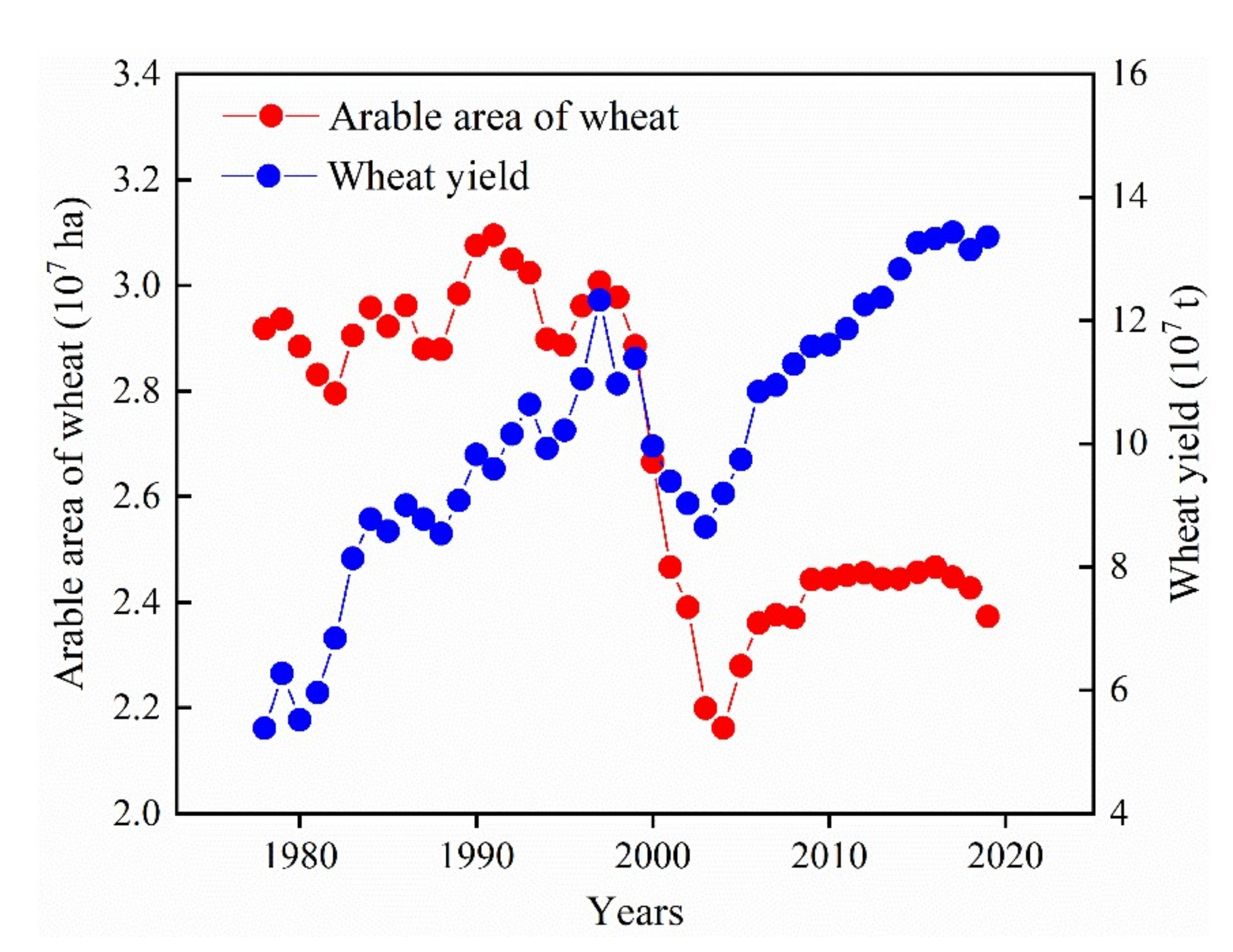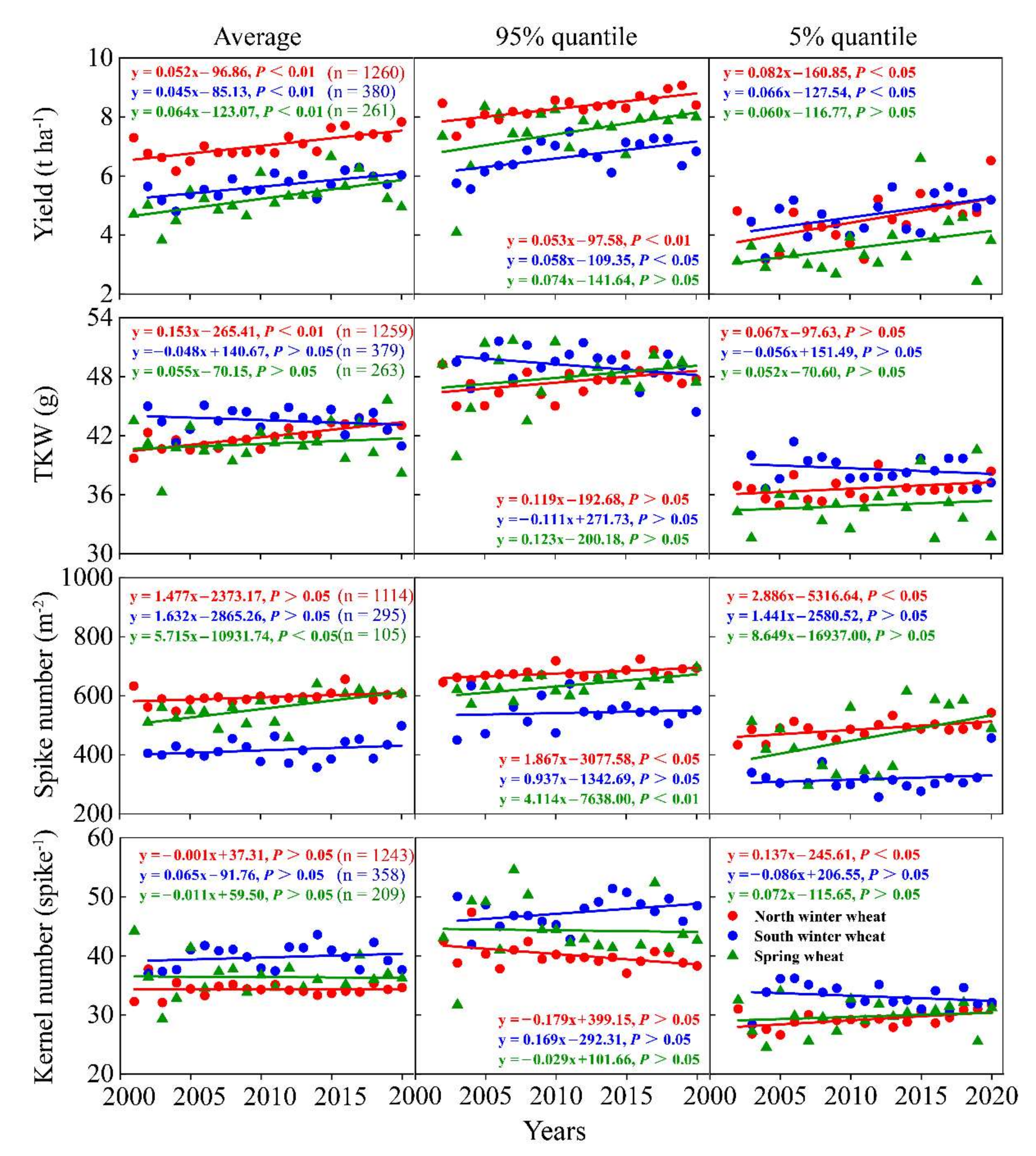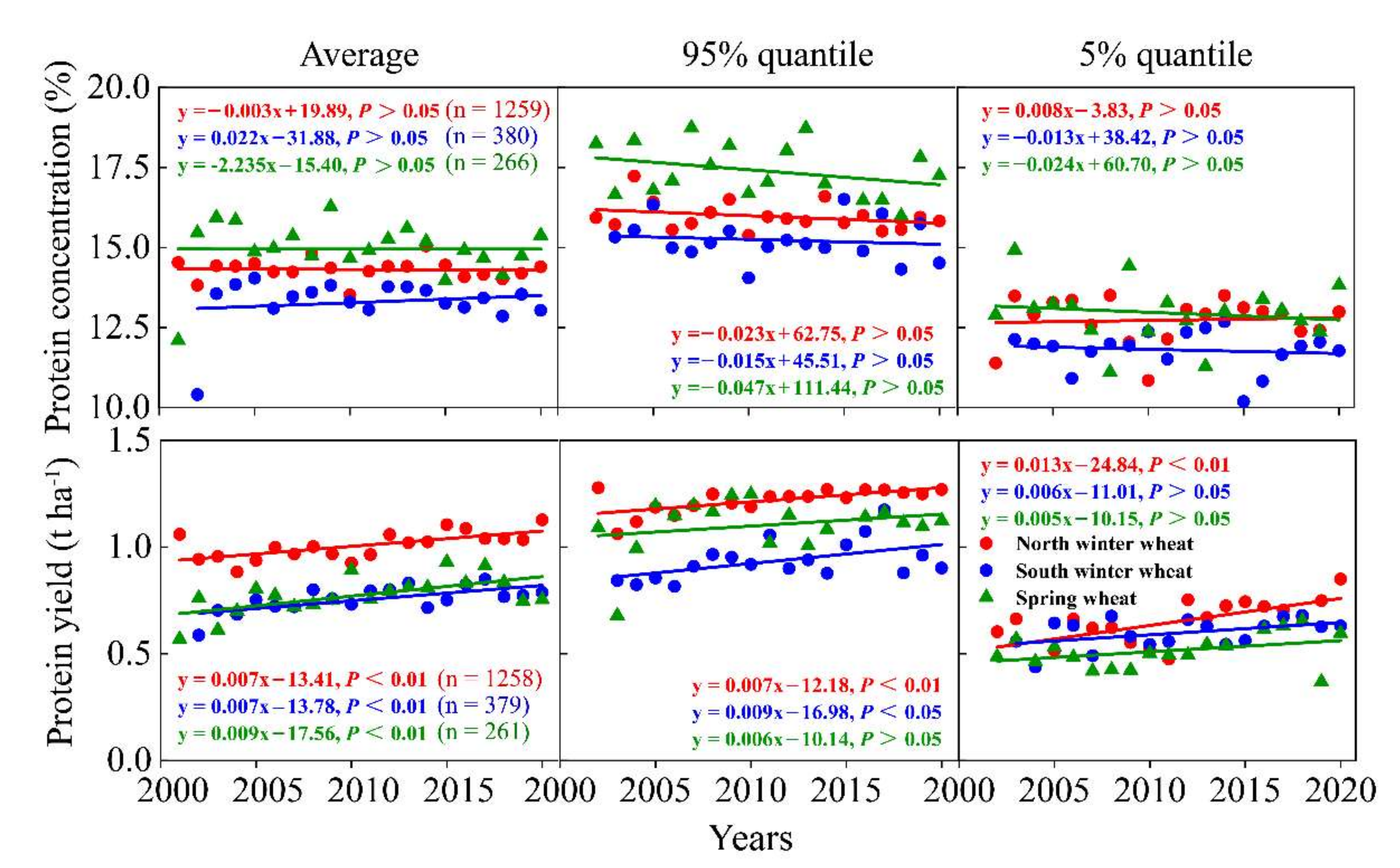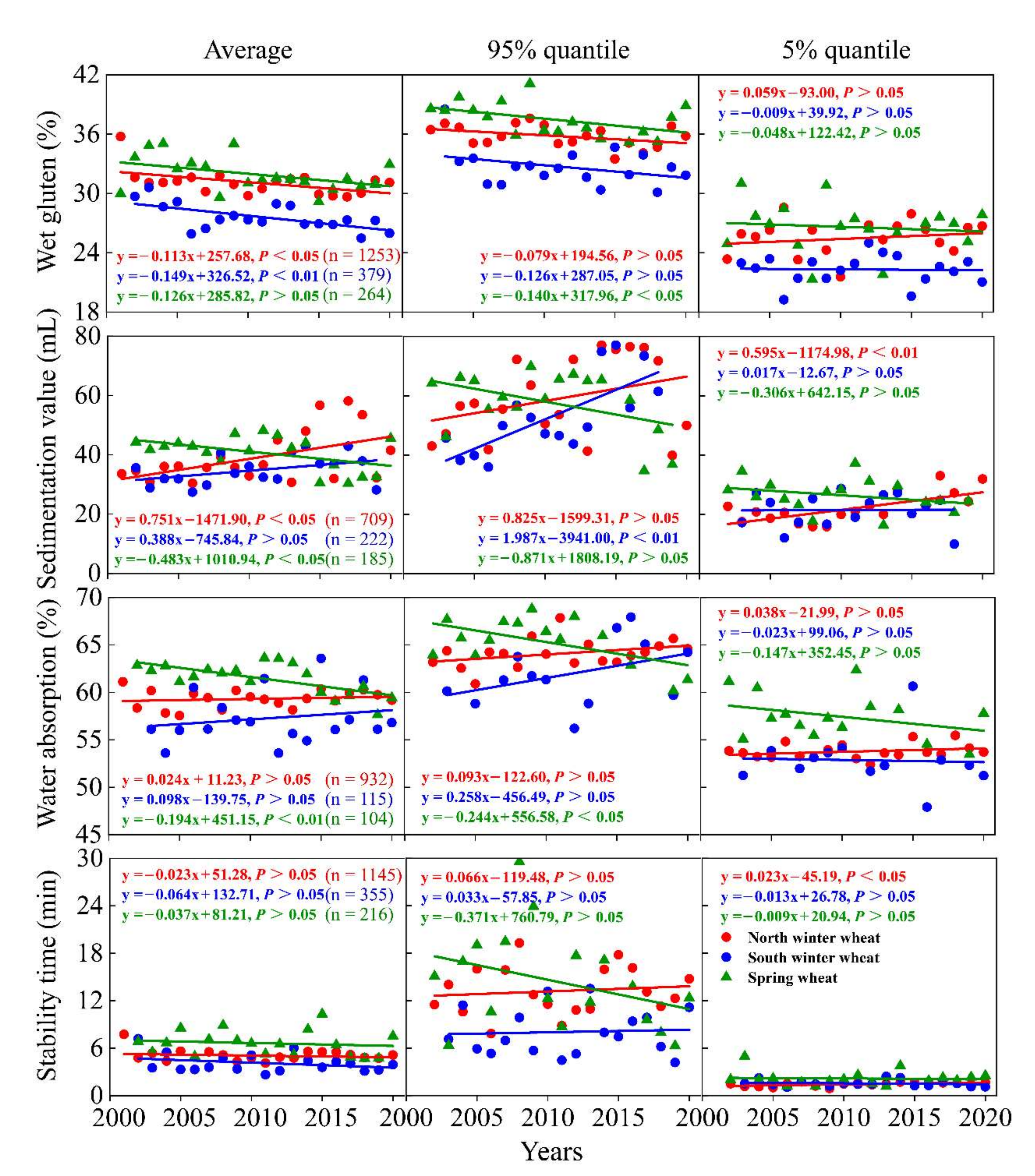Did Wheat Breeding Simultaneously Improve Grain Yield and Quality of Wheat Cultivars Releasing over the Past 20 Years in China?
Abstract
1. Introduction
2. Materials and Methods
3. Results
3.1. Statistics of Grain Yield and Quality Parameter
3.2. Grain Yield and Yield Components
3.3. Protein Concentration, Protein Yield, and Protein Quality
3.4. Genetic Yield Potential and Genetic Yield Gap
4. Discussion
4.1. Breeding Progress of Wheat Yield
4.2. Breeding Progress of Wheat Quality
4.3. The Relationship between Wheat Yield and Protein Concentration
5. Conclusions
Supplementary Materials
Author Contributions
Funding
Data Availability Statement
Acknowledgments
Conflicts of Interest
References
- Qin, X.; Zhang, F.; Liu, C.; Yu, H.; Cao, B.; Tian, S.; Liao, Y.; Siddique, K.H.M. Wheat yield improvements in China: Past trends and future directions. Field Crop. Res. 2015, 177, 117–124. [Google Scholar] [CrossRef]
- Mueller, N.D.; Gerber, J.S.; Johnston, M.; Ray, D.K.; Ramankutty, N.; Foley, J.A. Correction: Corrigendum: Closing yield gaps through nutrient and water management. Nature 2013, 494, 390. [Google Scholar] [CrossRef]
- Ortiz, R.; Braun, H.; Crossa, J.; Crouch, J.H.; Davenport, G.; Dixon, J.; Dreisigacker, S.; Duveiller, E.; He, Z.; Huerta, J.; et al. Wheat genetic resources enhancement by the International Maize and Wheat Improvement Center (CIMMYT). Genet. Resour. Crop. Ev. 2008, 55, 1095–1140. [Google Scholar] [CrossRef]
- Pingali, P.L. Green Revolution: Impacts, limits, and the path ahead. Proc. Natl. Acad. Sci. 2012, 109, 12302–12308. [Google Scholar] [CrossRef] [PubMed]
- Wang, F.; He, Z.; Sayre, K.; Li, S.; Si, J.; Feng, B.; Kong, L. Wheat cropping systems and technologies in China. Field Crop. Res. 2009, 111, 181–188. [Google Scholar] [CrossRef]
- Bodirsky, B.L.; Mueller, C. Robust relationship between yields and nitrogen inputs indicates three ways to reduce nitrogen pollution. Environ. Res. Lett. 2014, 9, 111005. [Google Scholar] [CrossRef]
- Tilman, D.; Fargione, J.; Wolff, B.; D’Antonio, C.; Dobson, A.; Howarth, R.; Schindler, D.; Schlesinger, W.H.; Simberloff, D.; Swackhamer, D. Forecasting agriculturally driven global environmental change. Science 2001, 292, 281–284. [Google Scholar] [CrossRef]
- Zheng, T.C.; Zhang, X.K.; Yin, G.H.; Wang, L.N.; Han, Y.L.; Chen, L.; Huang, F.; Tang, J.W.; Xia, X.C.; He, Z.H. Genetic gains in grain yield, net photosynthesis and stomatal conductance achieved in Henan Province of China between 1981 and 2008. Field Crop. Res. 2011, 122, 225–233. [Google Scholar] [CrossRef]
- Xiao, Y.G.; Qian, Z.G.; Wu, K.; Liu, J.J.; Xia, X.C.; Ji, W.Q.; He, Z.H. Genetic Gains in Grain Yield and Physiological Traits of Winter Wheat in Shandong Province, China, from 1969 to 2006. Crop. Sci. 2012, 52, 44–56. [Google Scholar] [CrossRef]
- Sun, Y.; Wang, X.; Wang, N.; Chen, Y.; Zhang, S. Changes in the yield and associated photosynthetic traits of dry-land winter wheat (Triticum aestivum L.) from the 1940s to the 2010s in Shaanxi Province of China. Field Crop. Res. 2014, 167, 1–10. [Google Scholar] [CrossRef]
- Yao, Y.; Lv, L.; Zhang, L.; Yao, H.; Dong, Z.; Zhang, J.; Ji, J.; Jia, X.; Wang, H. Genetic gains in grain yield and physiological traits of winter wheat in Hebei Province of China, from 1964 to 2007. Field Crop. Res. 2019, 239, 114–123. [Google Scholar] [CrossRef]
- Zhou, Y.; Zhu, H.Z.; Cai, S.B.; He, Z.H.; Zhang, X.K.; Xia, X.C.; Zhang, G.S. Genetic improvement of grain yield and associated traits in the southern China winter wheat region: 1949 to 2000. Euphytica 2007, 157, 465–473. [Google Scholar] [CrossRef]
- Zhang, X.; Davidson, E.A.; Mauzerall, D.L.; Searchinger, T.D.; Dumas, P.; Shen, Y. Managing nitrogen for sustainable development. Nature 2015, 528, 51–59. [Google Scholar] [CrossRef] [PubMed]
- Liu, W.; Yang, H.; Folberth, C.; Mueller, C.; Ciais, P.; Abbaspour, K.C.; Schulin, R. Achieving High Crop Yields with Low Nitrogen Emissions in Global Agricultural Input Intensification. Environ. Sci. Technol. 2018, 52, 13782–13791. [Google Scholar] [CrossRef]
- Li, S.; Lei, Y.; Zhang, Y.; Liu, J.; Shi, X.; Jia, H.; Wang, C.; Chen, F.; Chu, Q. Rational trade-offs between yield increase and fertilizer inputs are essential for sustainable intensification: A case study in wheat-maize cropping systems in China. Sci. Total Environ. 2019, 679, 328–336. [Google Scholar] [CrossRef] [PubMed]
- Haddad, L.; Hawkes, C.; Webb, P.; Thomas, S.; Beddington, J.; Waage, J.; Flynn, D. A new global research agenda for food. Nature 2016, 540, 30–32. [Google Scholar] [CrossRef] [PubMed]
- Asseng, S.; Martre, P.; Maiorano, A.; Roetter, R.P.; O’Leary, G.J.; Fitzgerald, G.J.; Girousse, C.; Motzo, R.; Giunta, F.; Babar, M.A.; et al. Climate change impact and adaptation for wheat protein. Glob. Change Biol. 2019, 25, 155–173. [Google Scholar] [CrossRef]
- Hu, X.; Sun, L.; Guiying, Z.; Wu, L.; Lu, W.; Li, W.; Wang, S.; Yang, X.; Song, J. Variations of Wheat Quality in China from 2006 to 2015. Sci. Agric. Sin. 2016, 49, 3063–3072. [Google Scholar]
- Shewry, P.R.; Halford, N.G. Cereal seed storage proteins: Structures, properties and role in grain utilization. J. Exp. Bot. 2002, 53, 947–958. [Google Scholar] [CrossRef]
- Uauy, C.; Brevis, J.C.; Dubcovsky, J. The high grain protein content gene Gpc-B1 accelerates senescence and has pleiotropic effects on protein content in wheat. J. Exp. Bot. 2006, 57, 2785–2794. [Google Scholar] [CrossRef]
- Hu, X. Study on the quality status of main wheat varieties in China and the variety evolution of winter wheat region in North China. Chin. Acad. Agric. Sci. 2006. [Google Scholar] [CrossRef]
- Yang, X.; Wu, L.; Zhu, Z.; Ren, G.; Liu, S. Variation and trends in dough rheological properties and flour quality in 330 Chinese wheat varieties. Crop. J. 2014, 2, 195–200. [Google Scholar] [CrossRef][Green Version]
- Lin, Z.; Chang, X.; Wang, D.; Zhao, G.; Zhao, B. Long-term fertilization effects on processing quality of wheat grain in the North China Plain. Field Crop. Res. 2015, 174, 55–60. [Google Scholar] [CrossRef]
- Nuttall, J.G.; O’Leary, G.J.; Panozzo, J.F.; Walker, C.K.; Barlow, K.M.; Fitzgerald, G.J. Models of grain quality in wheat-A review. Field Crop. Res. 2017, 202, 136–145. [Google Scholar] [CrossRef]
- Michel, S.; Loeschenberger, F.; Ametz, C.; Pachler, B.; Sparry, E.; Buerstmayr, H. Simultaneous selection for grain yield and protein content in genomics-assisted wheat breeding. Theor. Appl. Genet. 2019, 132, 1745–1760. [Google Scholar] [CrossRef]
- Shewry, P.R.; Halford, N.G.; Tatham, A.S.; Popineau, Y.; Lafiandra, D.; Belton, P.S. The high molecular weight subunits of wheat glutenin and their role in determining wheat processing properties. Adv. Food Nutr. Res. 2003, 45, 219–302. [Google Scholar] [PubMed]
- Jin, S. Wheat Cultivation in China; Agriculture Press: Beijing, China, 1961. [Google Scholar]
- China Statistical Yearbook; China Statistical Publishing House: Beijing, China, 2021.
- Fischer, T.; Byerlee, D.; Edmeades, G. Crop Yields and Global Food Security: Will Yield Increase Continue to Feed the World? ACIAR Monograph No. 158.; Australian Centre for International Agricultural Research: Canberra, Australia, 2014; Volume 158, pp. 1–634. [Google Scholar]
- Senapati, N.; Semenov, M.A. Large genetic yield potential and genetic yield gap estimated for wheat in Europe. Glob. Food Secur.-Agric. Policy Econ. Environ. 2020, 24, 100340. [Google Scholar] [CrossRef]
- Shi, Y.; Lou, Y.; Zhang, Y.; Xu, Z. Quantitative contributions of climate change, new cultivars adoption, and management practices to yield and global warming potential in rice-winter wheat rotation ecosystems. Agr. Syst. 2021, 190, 103087. [Google Scholar] [CrossRef]
- Asseng, S.; Cammarano, D.; Basso, B.; Chung, U.; Alderman, P.D.; Sonder, K.; Reynolds, M.; Lobell, D.B. Hot spots of wheat yield decline with rising temperatures. Glob. Change Biol. 2017, 23, 2464–2472. [Google Scholar] [CrossRef]
- Lobell, D.B.; Schlenker, W.; Costa-Roberts, J. Climate trends and global crop production since 1980. Science 2011, 333, 616–620. [Google Scholar] [CrossRef]
- Bai, H.; Tao, F.; Xiao, D.; Liu, F.; Zhang, H. Attribution of yield change for rice-wheat rotation system in China to climate change, cultivars and agronomic management in the past three decades. Clim. Change 2016, 135, 539–553. [Google Scholar] [CrossRef]
- Hawkesford, M.; Araus, J.; Park, R.; Calderini, D.; Miralles, D.; Shen, T.; Zhang, J.; Parry, M. Prospects of doubling global wheat yields. Food Energy Secur. 2013, 2, 34–48. [Google Scholar] [CrossRef]
- Hao, C.; Wang, L.; Zhang, X.; You, G.; Dong, Y.; Jia, J.; Liu, X.; Shang, X.; Liu, S.; Cao, Y. Evolution of genetic diversity of wheat cultivars bred in China. Sci. China 2005, 35, 27–34. [Google Scholar]
- China Statistical Yearbook; China Statistical Publishing House: Beijing, China, 2019.
- Gao, J.; Yang, X.; Zheng, B.; Liu, Z.; Zhao, J.; Sun, S.; Li, K.; Dong, C. Effects of climate change on the extension of the potential double cropping region and crop water requirements in Northern China. Agr. For. Meteorol. 2019, 268, 146–155. [Google Scholar] [CrossRef]
- Zoerb, C.; Ludewig, U.; Hawkesford, M.J. Perspective on Wheat Yield and Quality with Reduced Nitrogen Supply. Trends Plant Sci. 2018, 23, 1029–1037. [Google Scholar] [CrossRef]
- Fischer, R.A.T.; Edmeades, G.O. Breeding and Cereal Yield Progress. Crop. Sci. 2010, 50, 85–98. [Google Scholar] [CrossRef]
- Senapati, N.; Brown, H.E.; Semenov, M.A. Raising genetic yield potential in high productive countries: Designing wheat ideotypes under climate change. Agr. For. Meteorol. 2019, 271, 33–45. [Google Scholar] [CrossRef]
- Li, K.; Yang, X.; Liu, Z.; Zhang, T.; Lu, S.; Liu, Y. Low yield gap of winter wheat in the North China Plain. Eur. J. Agron. 2014, 59, 1–12. [Google Scholar] [CrossRef]
- Zhou, Y.; He, Z.H.; Sui, X.X.; Xia, X.C.; Zhang, X.K.; Zhang, G.S. Genetic Improvement of Grain Yield and Associated Traits in the Northern China Winter Wheat Region from 1960 to 2000. Crop. Sci. 2007, 47, 245–253. [Google Scholar] [CrossRef]
- Wang, Y.; Hao, C.; Zheng, J.; Ge, H.; Zhou, Y.; Ma, Z.; Zhang, X. A haplotype block associated with thousand-kernel weight on chromosome 5DS in common wheat (Triticum aestivum L.). J. Integr. Plant Biol. 2015, 57, 662–672. [Google Scholar] [CrossRef]
- Shewry, P.R.; Hassall, K.L.; Grausgruber, H.; Andersson, A.A.M.; Lampi, A.M.; Piironen, V.; Rakszegi, M.; Ward, J.L.; Lovegrove, A. Do modern types of wheat have lower quality for human health? Nutr. Bull. 2020, 45, 362–373. [Google Scholar] [CrossRef] [PubMed]
- Laidig, F.; Piepho, H.; Rentel, D.; Drobek, T.; Meyer, U.; Huesken, A. Breeding progress, environmental variation and correlation of winter wheat yield and quality traits in German official variety trials and on-farm during 1983–2014. Theor. Appl. Genet. 2017, 130, 223–245. [Google Scholar] [CrossRef] [PubMed]
- Michel, S.; Loeschenberger, F.; Ametz, C.; Pachler, B.; Sparry, E.; Buerstmayr, H. Combining grain yield, protein content and protein quality by multi-trait genomic selection in bread wheat. Theor. Appl. Genet. 2019, 132, 2767–2780. [Google Scholar] [CrossRef] [PubMed]
- He, Z.H. Wheat quality requirements in China. In Developments in Plant Breeding; Springer: Dordrecht, The Netherlands, 2001; Volume 9, pp. 279–284. [Google Scholar]
- Wang, H.; Ma, H.; Cao, L.; Sun, D.; Li, X.; Min, D.; Feng, Y. Current situation and problems of winter wheat variety quality in China. J. Northwest AF Univ. (Nat. Sci. Ed.) 2003, 31, 34–40. [Google Scholar]
- Zhang, Y.; Nagamine, T.; He, Z.H.; Ge, X.X.; Yoshida, H.; Pena, R.J. Variation in quality traits in common wheat as related to Chinese fresh white noodle quality. Euphytica 2005, 141, 113–120. [Google Scholar] [CrossRef]
- Zan, X.; Zhou, G.; Wu, L.; Wang, S.; Hu, X.; Lu, W.; Wang, B. Present Status of Wheat Quality in China. J. Triticeae Crops 2006, 26, 46–49. [Google Scholar]
- Mosleth, E.F.; Wan, Y.; Lysenko, A.; Chope, G.A.; Penson, S.P.; Shewry, P.R.; Hawkesford, M.J. A novel approach to identify genes that determine grain protein deviation in cereals. Plant Biotechnol. J. 2015, 13, 625–635. [Google Scholar] [CrossRef]
- Ben Mariem, S.; Gamez, A.L.; Larraya, L.; Fuertes-Mendizabal, T.; Canameras, N.; Araus, J.L.; Mcgrath, S.P.; Hawkesford, M.J.; Gonzalez Murua, C.; Gaudeul, M.; et al. Assessing the evolution of wheat grain traits during the last 166 years using archived samples. Sci. Rep. UK 2020, 10, 21828. [Google Scholar] [CrossRef]
- Koekemoer, F.P.; Labuschagne, M.T.; Van Deventer, C.S. A selection strategy for combining high grain yield and high protein content in South African wheat cultivars. Cereal Res. Commun. 1999, 27, 107–114. [Google Scholar] [CrossRef]
- Rapp, M.; Lein, V.; Lacoudre, F.; Lafferty, J.; Mueller, E.; Vida, G.; Bozhanova, V.; Ibraliu, A.; Thorwarth, P.; Piepho, H.P.; et al. Simultaneous improvement of grain yield and protein content in durum wheat by different phenotypic indices and genomic selection. Theor. Appl. Genet. 2018, 131, 1315–1329. [Google Scholar] [CrossRef]
- Michel, S.; Kummer, C.; Gallee, M.; Hellinger, J.; Ametz, C.; Akgöl, B.; Epure, D.; Löschenberger, F.; Buerstmayr, H. Improving the baking quality of bread wheat by genomic selection in early generations. Theor. Appl. Genet. 2018, 131, 477–493. [Google Scholar] [CrossRef] [PubMed]
- Wang, Y.; Zhen, S.; Luo, N.; Han, C.; Lu, X.; Li, X.; Xia, X.; He, Z.; Yan, Y. Low molecular weight glutenin subunit gene Glu-B3h confers superior dough strength and breadmaking quality in wheat (Triticum aestivum L.). Sci. Rep. UK 2016, 6, 27182. [Google Scholar] [CrossRef] [PubMed]
- Wang, J.; Wang, C.; Zhen, S.; Li, X.; Yan, Y. Low-Molecular-Weight gluten in subunits from the 1U genome of Aegilops umbellulata confer superior dough rheological properties and improve breadmaking quality of bread wheat. J. Sci. Food Agr. 2018, 98, 2156–2167. [Google Scholar] [CrossRef] [PubMed]
- Liu, J.; Feng, B.; Xu, Z.; Fan, X.; Jiang, F.; Jin, X.; Cao, J.; Wang, F.; Liu, Q.; Yang, L.; et al. A genome-wide association study of wheat yield and quality-related traits in southwest China. Mol. Breed. 2017, 38, 1–11. [Google Scholar] [CrossRef]




| Region | Statistics | Yield t ha−1 | TKW g | SN m−2 | KN Spike−1 | PC % | PY t ha−1 | WG % | SV mL | WA % | ST min |
|---|---|---|---|---|---|---|---|---|---|---|---|
| North winter wheat | Number | 1260 | 1259 | 1114 | 1243 | 1259 | 1258 | 1253 | 709 | 932 | 1145 |
| Min | 2.8 | 28.2 | 394 | 23.4 | 8.4 | 0.4 | 18.1 | 9.2 | 51.0 | 0.6 | |
| Max | 9.2 | 54.7 | 774 | 53.5 | 18.6 | 1.4 | 41.6 | 82.0 | 77.1 | 41.0 | |
| Average | 7.2 | 42.4 | 599 | 34.4 | 14.3 | 1.0 | 30.8 | 40.7 | 59.4 | 5.0 | |
| SD | 1.3 | 3.6 | 61 | 3.5 | 1.1 | 0.2 | 3.3 | 16.0 | 3.5 | 4.1 | |
| CV (%) | 18 | 9 | 10 | 10 | 7 | 18 | 11 | 39 | 6 | 82 | |
| South winter wheat | Number | 380 | 379 | 295 | 358 | 380 | 379 | 379 | 222 | 115 | 355 |
| Min | 3.2 | 34.9 | 249 | 27.0 | 8.5 | 0.4 | 15.9 | 8.0 | 40.0 | 0.5 | |
| Max | 7.9 | 60.0 | 713 | 55.2 | 17.3 | 1.3 | 39.0 | 83.5 | 68.2 | 26.7 | |
| Average | 5.8 | 43.4 | 423 | 39.9 | 13.4 | 0.8 | 27.3 | 35.5 | 57.0 | 4.0 | |
| SD | 0.8 | 3.7 | 93 | 5.2 | 1.3 | 0.1 | 3.8 | 13.2 | 4.6 | 3.0 | |
| CV (%) | 14 | 9 | 22 | 13 | 10 | 16 | 14 | 37 | 8 | 75 | |
| Spring wheat | Number | 261 | 263 | 105 | 209 | 266 | 261 | 264 | 185 | 104 | 216 |
| Min | 1.3 | 30.2 | 245 | 22.0 | 9.5 | 0.2 | 17.5 | 13.5 | 52.6 | 0.8 | |
| Max | 8.8 | 56.6 | 713 | 58.0 | 19.9 | 1.6 | 46.5 | 71.3 | 69.1 | 38.0 | |
| Average | 5.3 | 41.0 | 554 | 36.6 | 15.1 | 0.8 | 32.2 | 41.9 | 61.6 | 6.7 | |
| SD | 1.6 | 5.2 | 104 | 6.5 | 1.7 | 0.2 | 4.3 | 13.0 | 3.4 | 5.9 | |
| CV (%) | 31 | 13 | 19 | 18 | 11 | 29 | 13 | 31 | 6 | 87 |
| Region | Year | SG (%) | MSG (%) | MG (%) | WG (%) |
|---|---|---|---|---|---|
| North winter wheat | 2001–2005 | 16.5 | 11.3 | 70.4 | 1.7 |
| 2006–2010 | 3.6 | 11.1 | 84.6 | 0.8 | |
| 2011–2015 | 3.7 | 13.1 | 82.8 | 0.4 | |
| 2016–2020 | 3.9 | 13.9 | 81.7 | 0.6 | |
| 2001–2020 | 4.9 | 12.9 | 81.4 | 0.7 | |
| South winter wheat | 2001–2005 | 2.4 | 9.5 | 78.6 | 9.5 |
| 2006–2010 | 2.2 | 3.2 | 87.1 | 7.5 | |
| 2011–2015 | 4.2 | 8.3 | 75.0 | 12.5 | |
| 2016–2020 | 5.3 | 5.3 | 74.7 | 14.7 | |
| 2001–2020 | 3.9 | 6.0 | 78.2 | 11.8 | |
| Spring wheat | 2001–2005 | 25.5 | 17.6 | 52.9 | 3.9 |
| 2006–2010 | 12.9 | 18.8 | 65.9 | 2.4 | |
| 2011–2015 | 11.5 | 21.2 | 65.4 | 1.9 | |
| 2016–2020 | 11.5 | 23.1 | 64.1 | 1.3 | |
| 2001–2020 | 14.7 | 20.3 | 62.8 | 2.3 |
| Period | Variable | North Winter Wheat | South Winter Wheat | Spring Wheat |
|---|---|---|---|---|
| 2001–2010 | Genetic yield potential (t ha−1) | 8.23 | 6.96 | 8.20 |
| Actual yield (t ha−1) | 5.33 | 4.08 | 3.96 | |
| Genetic yield gap (t ha−1) | 2.91 | 2.88 | 4.25 | |
| Genetic yield gap percentage (%) | 35 | 41 | 52 | |
| 2001–2020 | Genetic yield potential (t ha−1) | 8.65 | 7.14 | 8.10 |
| Actual yield (t ha−1) | 6.17 | 5.08 | 4.38 | |
| Genetic yield gap (t ha−1) | 2.47 | 2.06 | 3.72 | |
| Genetic yield gap percentage (%) | 29 | 29 | 46 |
| Yield Components | Variable | North Winter Wheat | South Winter Wheat | Spring Wheat |
|---|---|---|---|---|
| TKW (g) | GYCP | 43.69 | 43.63 | 48.02 |
| AYC | 42.39 | 43.36 | 41.04 | |
| IR | 3% | 1% | 17% | |
| Spike number (m−2) | GYCP | 631 | 482 | 620 |
| AYC | 599 | 423 | 554 | |
| IR | 5% | 14% | 12% | |
| Kernel number (spike−1) | GYCP | 35.52 | 40.54 | 40.73 |
| AYC | 34.44 | 39.91 | 36.59 | |
| IR | 3% | 2% | 11% |
Publisher’s Note: MDPI stays neutral with regard to jurisdictional claims in published maps and institutional affiliations. |
© 2022 by the authors. Licensee MDPI, Basel, Switzerland. This article is an open access article distributed under the terms and conditions of the Creative Commons Attribution (CC BY) license (https://creativecommons.org/licenses/by/4.0/).
Share and Cite
Hu, N.; Du, C.; Zhang, W.; Liu, Y.; Zhang, Y.; Zhao, Z.; Wang, Z. Did Wheat Breeding Simultaneously Improve Grain Yield and Quality of Wheat Cultivars Releasing over the Past 20 Years in China? Agronomy 2022, 12, 2109. https://doi.org/10.3390/agronomy12092109
Hu N, Du C, Zhang W, Liu Y, Zhang Y, Zhao Z, Wang Z. Did Wheat Breeding Simultaneously Improve Grain Yield and Quality of Wheat Cultivars Releasing over the Past 20 Years in China? Agronomy. 2022; 12(9):2109. https://doi.org/10.3390/agronomy12092109
Chicago/Turabian StyleHu, Naiyue, Chenghang Du, Wanqing Zhang, Ying Liu, Yinghua Zhang, Zhigan Zhao, and Zhimin Wang. 2022. "Did Wheat Breeding Simultaneously Improve Grain Yield and Quality of Wheat Cultivars Releasing over the Past 20 Years in China?" Agronomy 12, no. 9: 2109. https://doi.org/10.3390/agronomy12092109
APA StyleHu, N., Du, C., Zhang, W., Liu, Y., Zhang, Y., Zhao, Z., & Wang, Z. (2022). Did Wheat Breeding Simultaneously Improve Grain Yield and Quality of Wheat Cultivars Releasing over the Past 20 Years in China? Agronomy, 12(9), 2109. https://doi.org/10.3390/agronomy12092109





